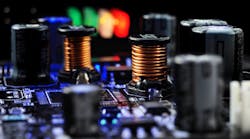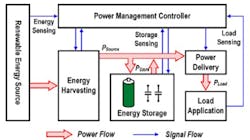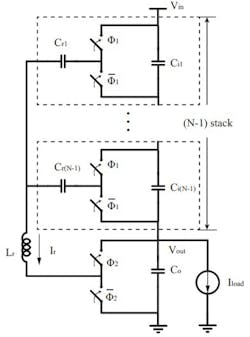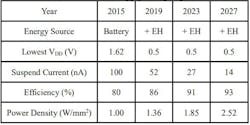This article is part of the TechXchange: Delving into EMI, EMC and Noise.
Members can download this article in PDF format.
What you'll learn:
- Underlying concepts of switched-capacitor circuits.
- IoT power management using a resonant switched-capacitor dc-dc converter or ultra-low-power switched-capacitor voltage regulators.
For Part 2, go here.
Modern switched-capacitor (SC) integrated circuits (ICs) for IoT power solutions are monolithic with simple control and low electromagnetic interference (EMI). System energy and power-management techniques help continuously reduce IoT cost and power. Modern load applications for function modules like memories, radio, sensors, and processors must run on an ultra-low power budget.
Switched-Capacitor Circuitry
Medical electronics, such as pacemakers, defibrillators, electronic watches, and so much more, rely on SC technology. The highly esteemed James Maxwell described the mathematical and operating principle of SC circuits about 150 years ago. Maxwell put forward two underlying concepts here:
- Capacitors are lossless memory devices, whereas resistors are memory-less dissipative devices. Adding periodically operated switches to a capacitor will erase its memory while causing dissipation. So now the average behavior will be much like a resistor.
- Quantized operation of the new circuit in item 1 will lead to the current having charge pulses instead of a continuously flowing current. In most cases the new circuit can be designed and analyzed via the use of sampled-data arithmetic, i.e., z-transforms.
Thus, replacing resistors with switched capacitors will enable the conversion of active RC filters into active SC-C filters.1 We know that the inaccuracy of the implemented RC product in CMOS will typically be greater than 30%. In an SC circuit, both the capacitance ratio C1/C2 and the clock frequency, fC, can be achieved with better than 0.05% accuracy.
IoT Power Management
The power management of an IoT node requires a well-planned and active engagement of energy harvesting, power delivery, and storage. Power interface circuits like dc-dc power converters and ac-dc rectifiers need to be able to adapt to a wide variety of input voltages, when ambient energy source(s) are the power input(s). The power-management unit (PMU) will then coordinate energy usage via adaptive online energy storage and power delivery (Fig. 1).
To facilitate low-power operation in the IoT, power circuit designs must be able to convert a widely variable input-voltage range to a low-level supply voltage at high levels of efficiency.
Stacked Resonant Switched-Capacitor DC-DC Converter
Electronic systems for the IoT usually need to be powered via a single cell lithium-ion (Li-ion) battery. Battery life must be extended. Moreover, the overall design constraints plus physical size in a power-conversion stage will need to be ready to deliver battery power spanning 3.2 to 4.2 V to the communication processors and application processors, which will require 1 V or less.
A typical conventional buck converter with a 3.2- to 4.2-V input range needs switches that will not usually be available in a standard CMOS submicron technology. To create an efficient implementation of a conventional buck converter, a large off-chip inductor must be used.
A common SC converter will lack efficiency at voltage regulation and prove to be limited in capacitor energy utilization. Equipping SC converters with an input range that’s capable of a Li-ion battery to the processor supply voltage requires a topology reconfiguration. Such additional functionality will necessitate further implementation and design complexity.
Figure 2 demonstrates a general, single-phase N-to-1 stacked resonant switched-capacitor architecture.2 Where switched capacitors are employed, designers will need to pay attention to possible EMI disruptions.
In Figure 2, the capacitors Cr1 to Cr(N−1) and Co are all dc bypass capacitors dividing the input voltage into N stacked dc domains. A pair of complementary switches is situated in each dc domain. The capacitors Cr1 to Cr(N−1) are resonant capacitors that can manage the major power flow. Since all of the resonant capacitors are in series with a single inductor Lr, no charge sharing losses occur during power transfer.
Due to the stacking structure, all switches are just rated for their local domain voltage, which is nominally 1/N of the input voltage. In addition, the upper N-1 resonant stages share the resonant current. Therefore, each stage will only be rated for its own fractional portion of the resonant current.
N is the number of stacking stages that can be adjusted accordingly. As a result, the advanced CMOS process can be used in these kinds of high-voltage, high-conversion-ratio applications.
Another nice feature of the Stacked ResSC is the ability of soft charging for all working capacitors with a minimum inductance. This stacking feature also enables the topology’s adaptability to bridge a high input voltage.
Ultra-Low-Power SC Voltage Regulators
Combining monolithic integration with low EMI and a very simple control method can create a switched-capacitor voltage regulator for the IoT.4
Cost and power of this kind of design architecture are both critically necessary for success in such a switched-capacitor voltage regulator architecture for the IoT. Power/energy management must strive for a goal of 10 µW/MHz for a processor, and a range of 1 to 2 mW for the radio, with an ultimate low-cost target of $0.50.
Figure 1 explains how designers can extend system runtime while improving energy efficiency. The system load, with function modules like memory, radio, sensors, and processors. needs to perform with an ultra-low power budget.
Energy harvesting is vital for IoT nodes to be autonomous, with very low maintenance, while striving toward lower cost and power. The International Technology Roadmap for Semiconductors (ITRS) in Figure 3 outlines IoT power-supply design specifications.
Research continues in improving state-of-the-art SC voltage regulators for an ultra-low-power IoT. Very low input voltages must be looked at regarding the issue of self-startup. This will necessitate better solutions for device threshold manipulation or improved SC topologies. A reconfigurable SC topology is critical for the IoT to have wide-input operation, and energy harvesting should be integrated to achieve a long system runtime.
Finally, designers need to watch out for any switching-induced EMI that may interfere with the proper function of these kinds of power ICs.
Summary
This article discusses state-of-the-art SC voltage regulators for ultra-low-power use in the IoT. EMI lurks in and around these kinds of sensitive circuitry, so methods must be deployed to minimize it. It’s essential that a switching system doesn’t interfere with the performance of the rest of the circuitry in the design.
Read more articles in the TechXchange: Delving into EMI, EMC and Noise.
References
1. “Switched-Capacitor Circuits,” David J. Allstot, Un-Ku Moon, and Gabor C. Temes, IEEE CICC 2022.
2. “Switched-Capacitor Power Electronics Circuits,” Adrian Ioinovici, Circuits and Systems (CAS) Technical Committee on Power Systems and Power Electronics Circuits (PSPEC).
3. “Design, Modeling and Control of the Integrated Stacked Resonant Switched Capacitor DC-DC Converter,” Yongjun Li, PhD, University of California at Berkeley, 2019.
4. “State-of-the-Art Monolithic Switched-Capacitor Voltage Regulators for Ultra-Low Power Internet of Things,” Kang Wei and D. Brian Ma, Integrated Power System Laboratory, IEEE 2018.
5. EE247, Lecture 9, “Switched-Capacitor Filters,” University of California/Berkeley, 2004.




